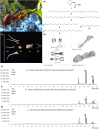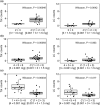Pollination by sexual deception via pro-pheromone mimicry?
- PMID: 40211617
- PMCID: PMC12095990
- DOI: 10.1111/nph.70131
Pollination by sexual deception via pro-pheromone mimicry?
Keywords: Ichneumonid wasp; chemical ecology; orchid; pollination; pro‐pheromone mimicry; sexual deception.
Conflict of interest statement
None declared.
Figures


Similar articles
-
Orchid pollination by sexual deception: pollinator perspectives.Biol Rev Camb Philos Soc. 2011 Feb;86(1):33-75. doi: 10.1111/j.1469-185X.2010.00134.x. Biol Rev Camb Philos Soc. 2011. PMID: 20377574 Review.
-
Colour mimicry and sexual deception by Tongue orchids (Cryptostylis).Naturwissenschaften. 2010 Jan;97(1):97-102. doi: 10.1007/s00114-009-0611-0. Epub 2009 Oct 2. Naturwissenschaften. 2010. PMID: 19798479
-
Discovery of pyrazines as pollinator sex pheromones and orchid semiochemicals: implications for the evolution of sexual deception.New Phytol. 2014 Aug;203(3):939-52. doi: 10.1111/nph.12800. Epub 2014 Apr 3. New Phytol. 2014. PMID: 24697806
-
The Spider Orchid Caladenia crebra Produces Sulfurous Pheromone Mimics to Attract its Male Wasp Pollinator.Angew Chem Int Ed Engl. 2017 Jul 10;56(29):8455-8458. doi: 10.1002/anie.201702864. Epub 2017 Jun 1. Angew Chem Int Ed Engl. 2017. PMID: 28470835
-
Mechanisms and evolution of deceptive pollination in orchids.Biol Rev Camb Philos Soc. 2006 May;81(2):219-35. doi: 10.1017/S1464793105006986. Biol Rev Camb Philos Soc. 2006. PMID: 16677433 Review.
References
-
- Ackerman JD, Phillips RD, Tremblay RL, Karremans A, Reiter N, Peter CI, Bogarín D, Pérez‐Escobar OA, Liu H. 2023. Beyond the various contrivances by which orchids are pollinated: global patterns in orchid pollination biology. Botanical Journal of the Linnean Society 202: 295–324.
-
- Ayasse M, Stökl J, Francke W. 2011. Chemical ecology and pollinator‐driven speciation in sexually deceptive orchids. Phytochemistry 72(13): 1667–1677. - PubMed
-
- Bartelt R, Jones R, Kulman H. 1982. Hydrocarbon components of the yellowheaded spruce sawfly sex pheromone: a series of (Z, Z)‐9, 19 dienes. Journal of Chemical Ecology 8: 95–114. - PubMed
-
- Bartelt RJ, Cossé AA, Petroski RJ, Weaver DK. 2002. Cuticular hydrocarbons and novel alkenediol diacetates from wheat stem sawfly (Cephus cinctus): natural oxidation to pheromone components. Journal of Chemical Ecology 28: 385–405. - PubMed
-
- Bartelt RJ, Jones RL. 1983. (Z)‐10‐nonadecenal: a pheromonally active air oxidation product of (Z, Z)‐9, 19 dienes in yellowheaded spruce sawfly. Journal of Chemical Ecology 9: 1333–1341. - PubMed
LinkOut - more resources
Full Text Sources

